Shutterbugs of Every Stripe
Fill Paris Galleries
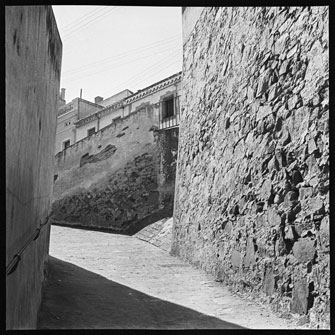
“El Masnou, Catalogne, Espagne” (1955), by Carlos Cruz-Diez.
Photography lovers have reason to rejoice in November, the biannual Mois de la Photo in Paris, but they will be hard put to find time to see all the dozens of exhibitions and photo fairs (see “Events” on the home page for a list of the latter) being held, but luckily many of them will continue well beyond November. Among them are must-see shows like Garry Winogrand at the Jeu de Paume, but there are also many, many interesting exhibitions of more obscure or up-and-coming shutter-snappers.
Michel Houellebecq
One of the themes of the event is amateur photography (the other two are the Mediterranean and “intimacy”). Writer Michel
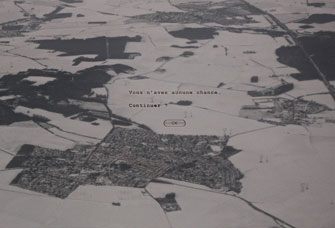
“Mission #01,” by Michel Houellebecq.
Houellebecq, whose show at the Pavillon Carré de Baudouin is called “Before Landing,” falls into the amateur category. According to Marc Lathuillière, curator of the exhibition and a photographer himself (see below for a review of his exhibition), Houellebecq’s show should be perceived as “the world seen through words translated into images.”
Houellebecq has plucked photos from some 30 years of picture-taking and organized them into vaguely thematic rooms, with little stylistic consistency from one room to the next – there are digital and analog photos; sumptuous color landscapes; backlit, color-saturated pictures of kitschy scenes or advertising posters; photos with superimposed images or words – but there is a point of view, or rather several points of view.
One is a kind of Beckettian “I can’t go on, I’ll go on” philosophy, best expressed in a grayish image of the earth seen from an airplane with an overlay of the kind of message that sometimes pops up on a computer screen: “Vous n’avez aucune chance. Continuer?” (“You haven’t got a chance. Continue?”). The only possible response is “Oui.” Another theme is the museumification of France as industry disappears, which Houellebecq does not see as a bad thing.
Houellebecq’s stance is similar to the position he takes in his books: a kind of affectless view of the world observed from a distance – you
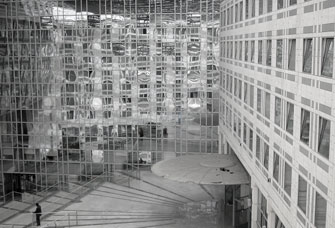
“France #05,” by Michel Houellebecq.
won’t see many human beings in these images. When asked about the show’s title at a press conference, he articulated his detachment when he spoke about the comfortable feeling he has when driving on a highway or riding on a train. “You feel good,” he says, “but you don’t know what you will find when you get out. That’s when the trouble starts.”
Marc Lathuillière
“Musée Nationale,” Lathuillière’s exhibition at the Galerie Binôme, is something of a companion piece to Houellebecq’s, but with a
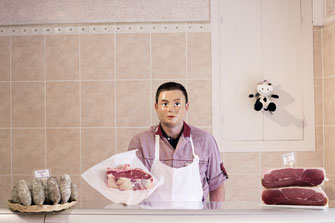
“La Viande de Qualité – Alain Daire, Boucher, Cunlhat (Puy-de-Dôme),” by Marc Lathuillière. Courtesy Galerie Binôme.
very different style and an opposing point of view that critiques the museumification of France with handsome color photos of typical scenes of French life with one small difference: the main character in each scene wears a mask (the same one in each photo), robbing the image of its picture-postcard perfection with its creepy, uniform frozen face.
As Houellebecq puts it in his catalog text for the exhibition, the masks are so disquieting to the viewer because they “contaminate” each of the scenes by “introducing doubt about their authenticity” and make it seem that the

“La Société du Musée – Jean Lorentz, Président, Société Schongauer, Musée Unterlinden, Colmar (Haut-Rhin),” by Marc Lathuillière. Courtesy Galerie Binôme.
figures are simply playing a role, transforming the French into “not only tourists in our own country, but also tourism actors” who have agreed “to play the role of French people for the benefit of international tourists.”
Jacques-André Boiffard
In the obscure category is “Jacques-André Boiffard: La Parenthèse Surréaliste,” the exhibition that inaugurates the Centre Pompidou’s new photography gallery. As a young man, Boiffard (1902-61), today pretty
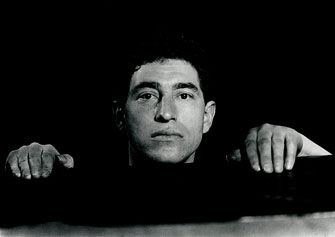
“Alberto Giacometti” (c. 1930), by Jacques-André Boiffard. Photo: © Centre Pompidou, MNAM/CCI, Dist. RMN-GP/image Centre Pompidou, MNAM/CCI © Mme Denise Boiffard
much forgotten, was an active, card-carrying member of the Surrealist movement (until he was formally thrown out, like so many others, by the doctrinaire Surrealist leader André Breton), contributing texts and photos to Surrealist publications, including a series of photos of Paris for a book by Breton, which were uncredited in the original edition.
Boiffard learned many tricks of the photography trade by working as an assistant to American-in-Paris Surrealist Man Ray. He

“Photogramme” (c. 1930), by Jacques-André Boiffard. Photo: © Centre Pompidou, MNAM/CCI, Dist. RMN-GP/G. Meguerditchian © Mme Denise Boiffard
used Ray’s camera-free photogram technique (placing objects directly on photographic paper and exposing them to light) to good effect in some near-abstract works made using liquids rather than objects.
In 1935, after an exciting decade, Boiffard gave up the artistic life and went to back to medical school to become a radiologist. The talent he showed in his early years of experimentation in photography, evident in this small exhibition, makes one wonder what direction he would have taken had he continued.
Dirk Braeckman
Le Bal, a photography exhibition space where you are always sure of seeing something a bit out of the ordinary, has a show of works by Dirk Braeckman, a Belgian photographer whose subject matter, often banal – a bench, a rug, a bedspread – varies widely. What makes his images unique is the way he reworks the
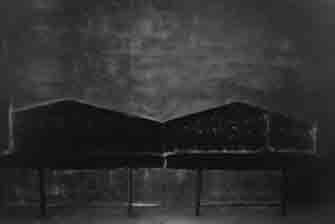
“Z.D.-L.O.-97” (1997) © Dirk Braeckman. Courtesy of Zeno X Gallery, Antwerp.
negatives and prints, playing with them until they conform to his aesthetic vision, which is all about shades of gray. Braeckman finds beauty in gray the way that Pierre Soulages finds beauty in black.
In a sense, these pictures are a throwback to the days when photography was not considered an art form, and photographers imitated painting rather than embracing photography for its own sake. Braeckman doesn’t imitate painting, but his atmospheric images, many of them quite beautiful (especially the more
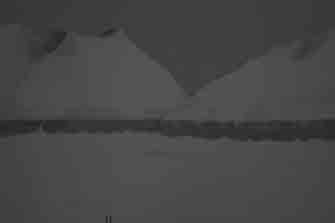
“27.1 21.7 044 2014” (2014) © Dirk Braeckman. Courtesy of Zeno X Gallery, Antwerp.
abstract ones), sometimes look more like paintings than photos. “I don’t set out to make my work more painterly by adopting a specific technique,” he says. “I do consider the image in the same pictorial terms as a painter, but the language I use is always photographic.”
Carlos Cruz-Diez
The Maison de l’Amérique Latine has an exhibition of more traditional photos by kinetic artist Carlos Cruz-Diez, a Venezuelan who lives
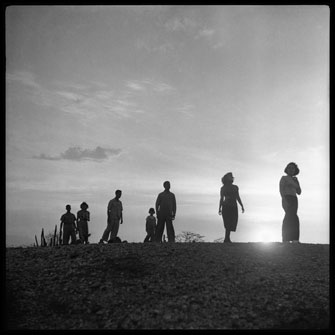
“Galipán, Colline El Ávila, Vargas, Venezuela” (1950), by Carlos Cruz-Diez.
in Paris and is also an accomplished photographer. The handsome black-and-white images in “Cruz-Diez en Noir et Blanc” document his travels in Venezuela, France, Spain, the Netherlands and the United States from 1947 to 1975. In addition to a number of pictures and films recording folk rituals and village life in rural Venezuela, you’ll find
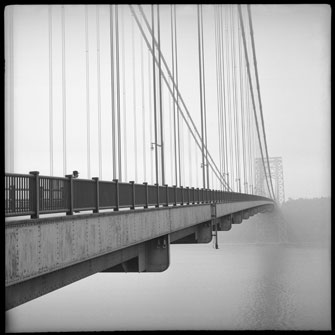
“George Washington Bridge, New York, United States” (1947), by Carlos Cruz-Diez.
everything from a stunning image of New York’s George Washington Bridge in the fog to portraits of fellow kinetic artists Alexander Calder and Jésus Rafael Soto.
Click here for the Mois de la Photo program.
Pavillon Carré de Baudouin: 121, rue de Ménilmontant, 75020 Paris. Métro: Gambetta. Tel.: 01 58 53 55 40. Open Tuesday-Saturday, 11am-6pm. Free admission. Through January 31, 2015. www.carredebaudouin.fr
Galerie Binôme: 19, rue Charlemagne, 75004 Paris. Métro: Saint-Paul or Pont-Marie. Tel.: 01 42 74 27 25. Open Tuesday-Wednesday, 1pm-7pm; Thursday-Saturday, 11am-7pm; or by appointment. Through December 20. www.galeriebinome.com
Centre Pompidou: 19, rue Beaubourg, 75004 Paris. Tel.: 01 44 78 12 33. Open 11am-9pm. Closed Tuesday. Métro: Rambuteau. Admission: free for this exhibition. Through February 2, 2015. www.centrepompidou.fr
Le Bal: 6, impasse de la Défense, 75018 Paris. Tel.: 01 44 70 75 50. Open Wednesday-Saturday, noon-8pm (Thursday until 10pm); Sunday, 11am-7pm. Closed December 25 and January 1. Admission: €5. Through January 4, 2015. www.le-bal.fr
Maison de l’Amérique Latine: 217, boulevard Saint-Germain 75007 Paris. Métro: Solferino. Tel.: 01 49 54 75 00. Open Monday-Friday, 10am-8pm to: Saturday 2pm-6pm. Admission: free. Through January 31, 2015. www.mal217.org
Click here to read all of this week’s new articles on the Paris Update home page.
Reader Reaction: Click here to respond to this article (your response may be published on this page and is subject to editing).
Support Paris Update by ordering books from Paris Update’s Amazon store at no extra cost. Click on your preferred Amazon location: U.K., France, U.S.
© 2014 Paris Update
Favorite